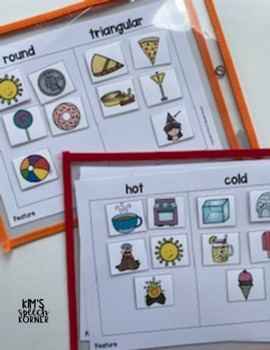Feature Function Class | Categories and Attributes Activities
Kim's Speech Korner
2.9k Followers
Grade Levels
PreK - 2nd
Resource Type
Standards
CCSSL.K.5a
CCSSL.K.5b
CCSSL.K.5c
CCSSL.1.5a
CCSSL.1.5b
Formats Included
- PDF
Pages
37 pages
Kim's Speech Korner
2.9k Followers
What educators are saying
I’ve used the resource for a students IEP goal related to attributes. It’s a great resource to increase student independence of these skills.
Great Resource and very engaging for my students. This resource adds a hands-on approach to category matching.
Description
Are you looking for an easy to target attributes in speech therapy? Do your student do best with hands-on, interactive activities? Then this resource is for you! Students
sort the 200 pictured objects by FEATURE, FUNCTION, and CLASS. Great for targeting opposites, as well.
Product Features:
- 200 brightly colored pictured nouns (1.5" x 1.75")
- 20 Features categories (hot/cold; big/small; hard/soft; long/short; fast/slow; light/heavy; curly/straight; round/triangular; sharp/smooth; living/non-living)
- 10 Functions categories (eat; wear; ride on; play with; write with; drink; cut with; fly; hop; clean with)
- 10 Classes categories (kitchen supplies; school supplies; clothing; furniture; plants; vehicles; zoo animals; farm animals; musical instruments; body parts)
- Words Lists (to help keep you organized, and for quick reference)
- "More Attributes" handout to use as a visual for students to brainstorm additional attributes. (Color-coded to correspond with EET beads.)
Total Pages
37 pages
Answer Key
N/A
Teaching Duration
Lifelong tool
Report this resource to TPT
Reported resources will be reviewed by our team. Report this resource to let us know if this resource violates TPT’s content guidelines.
Standards
to see state-specific standards (only available in the US).
CCSSL.K.5a
Sort common objects into categories (e.g., shapes, foods) to gain a sense of the concepts the categories represent.
CCSSL.K.5b
Demonstrate understanding of frequently occurring verbs and adjectives by relating them to their opposites (antonyms).
CCSSL.K.5c
Identify real-life connections between words and their use (e.g., note places at school that are colorful).
CCSSL.1.5a
Sort words into categories (e.g., colors, clothing) to gain a sense of the concepts the categories represent.
CCSSL.1.5b
Define words by category and by one or more key attributes (e.g., a duck is a bird that swims; a tiger is a large cat with stripes).





